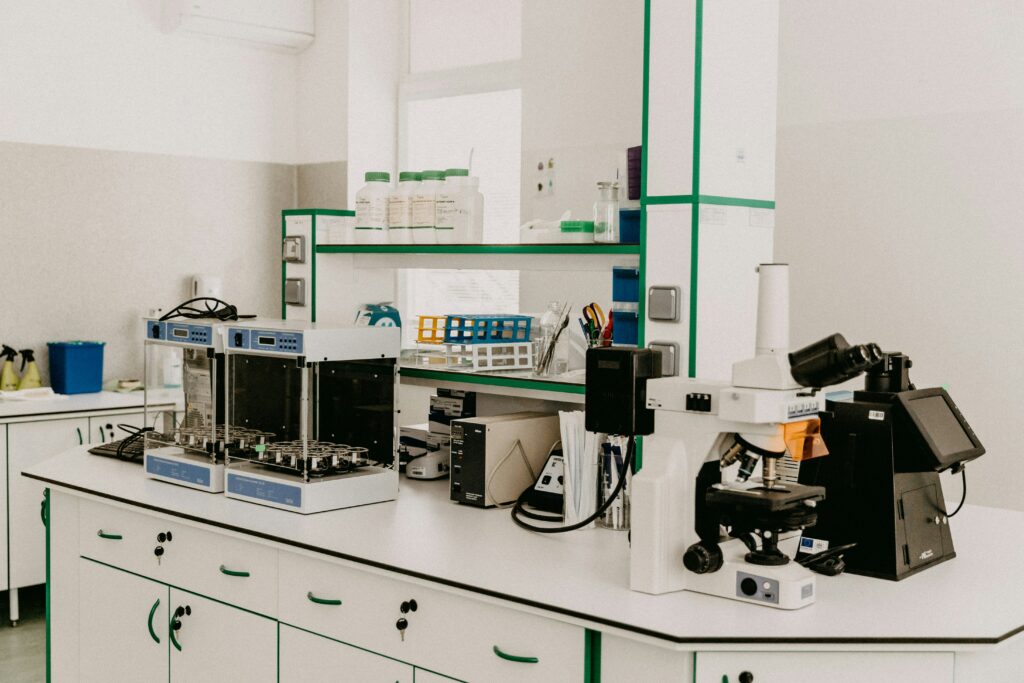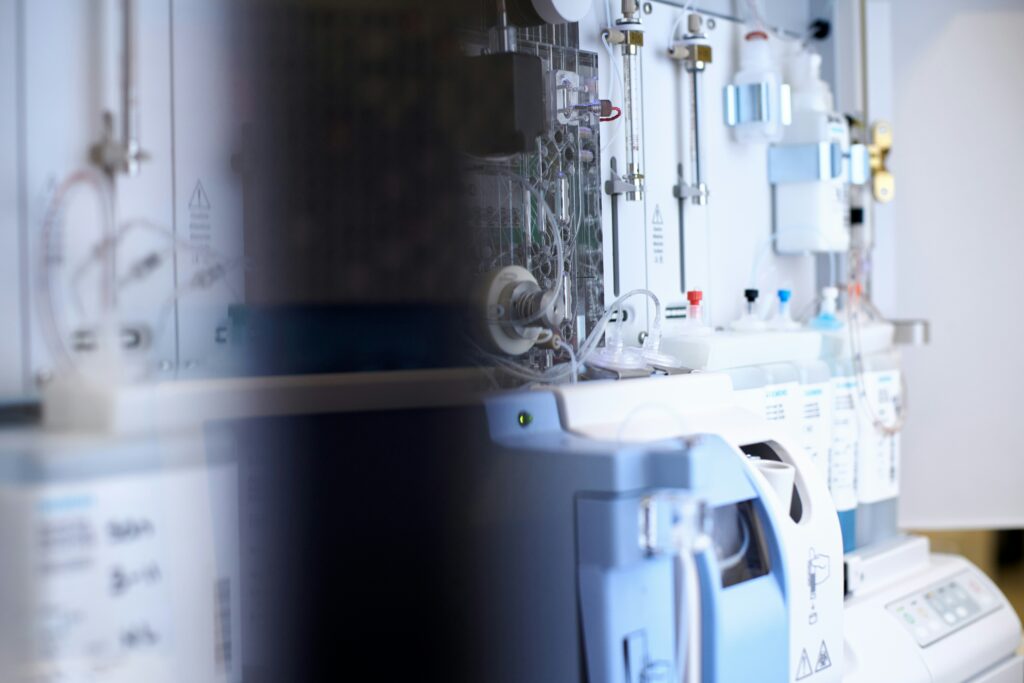Tandem mass spectrometry (MSMS) is a revolutionary technique in laboratory analysis. Thanks to its precision and ability to identify complex compounds, it has established itself as an essential tool in many scientific sectors. Its use is particularly valuable for manufacturers in the cosmetics and plant industries, where the characterization of active molecules, the detection of contaminants, and quality control are essential.
The MSMS technique is particularly suitable for detecting regulated preservatives such as parabens (methylparaben, propylparaben), phenoxyethanol or chlorophenesin, often present in trace amounts in formulations.
This article explores the principles, applications, and benefits of this method, while providing technical details to better understand how it works.
At Yes We Lab , we provide cutting-edge analytical solutions to support professionals with their specific needs. Our services cover the identification and quantification of active ingredients, the search for residues and impurities, as well as the authentication of raw materials. Thanks to state-of-the-art equipment and the expertise of our analysts, we guarantee reliable and accurate results, compliant with the regulatory requirements of the sector.
1. Introduction to mass spectrometry
Understanding Mass Spectrometry
Mass spectrometry is an analytical method that measures the masses of molecules or atoms in a sample. It relies on the transformation of these molecules into charged ions, which are then sorted according to their mass-to-charge ratio (m/z). This technique is capable of providing detailed information on the chemical composition and molecular structure of samples, even when they contain complex mixtures.
The components of a mass spectrometer
A typical mass spectrometer consists of three main components:
1. The ionization source : It converts the sample molecules into ions by exposing them to electron beams, lasers, or electric fields. This step is crucial to ensure accurate detection.
2. Mass analyzer : It separates the product ions based on their m/z ratio. Analyzers can be of several types, such as time-of-flight (TOF), quadrupole, or ion trap, each offering specific advantages depending on the application.
3. The detector : It measures the separated ions and translates this data into a mass spectrum, a graph representing the abundance of ions as a function of their m/z ratio.
The importance of the mass/charge ratio (m/z)
The m/z ratio is a fundamental measurement in mass spectrometry. It allows ions to be differentiated based on their mass and electrical charge. This ability to distinguish ions is essential for identifying molecules in complex mixtures or for analyzing fragments generated during degradation processes.
2. The basics of tandem mass spectrometry
What is tandem mass spectrometry?
Tandem mass spectrometry, often abbreviated as MS/MS, is a technique that combines two analytical steps in a single process. First, a specific parent ion is selected from a complex mixture of ions using a primary mass analyzer. This ion then undergoes a controlled fragmentation process in a collision cell, where it interacts with gases such as helium or argon. Finally, the resulting fragments, called daughter ions, are analyzed by a secondary mass analyzer. This dual analysis provides a better understanding of the chemical structure of the selected ion.
Key steps in the MS/MS process
The MS/MS process is based on a precise sequence of three main steps:
1. Selection of parent ions : In this first step, the first analyzer isolates an ion of interest based on its m/z ratio, eliminating other ions present in the sample.
2. Fragmentation in the collision cell : The selected ion enters a cell where it is fragmented by collisions with inert gas molecules. This process, called collision-activated dissociation (CID), generates fragments that carry information about the molecular structure of the original ion.
3. Fragment analysis : The generated fragments are then sorted and detected by the second mass analyzer, which produces a mass spectrum indicating their distribution based on their m/z ratio.
The technologies behind MS/MS
Several types of mass analyzers can be used in an MS/MS spectrometer. The most common include:
- Quadrupoles : These analyzers are widely used for their accuracy and versatility. They are particularly suitable for quantifying analytes in complex mixtures.
- Time of Flight (TOF) : This analyzer measures the time it takes for ions to travel a given distance, providing high resolution and accuracy in analyzing daughter ions.
- Ion traps : These devices confine ions in an electromagnetic field, allowing for fragmentation and in-depth analysis.
- The Orbitrap : Renowned for its exceptional resolution, this analyzer allows extremely precise measurements of m/z ratios, facilitating the identification of compounds.
The advantages of tandem mass spectrometry MS/MS offers several advantages that make it an essential tool for modern laboratories:
- Increased sensitivity, allowing the detection of analytes at very low concentrations.
- Exceptional specificity thanks to the precise selection of parent ions. ◦ Ability to analyze complex mixtures, even in biological or environmental matrices.

3. Practical applications of tandem mass spectrometry
Analysis of contaminants in the food industry
One of the most common uses of MS/MS is in the monitoring of contaminants in food . This technique is particularly effective in detecting and quantifying harmful substances such as mycotoxins , pesticides , and heavy metals. For example, it can detect traces of aflatoxins or ochratoxin A in cereals, dried fruits, or dairy products. The sensitivity of MS/MS guarantees reliable detection even at very low levels, often below the regulatory limits set by the European Union. Manufacturers use these analyses to guarantee consumer safety and ensure compliance with food standards.
Identification of biomolecules in human and animal health
In medical biology, MS/MS is an essential tool for analyzing complex biomolecules. It is commonly used for the measurement of vitamins (such as D2 and D3 forms), steroid hormones (testosterone, cortisol), and amino acids. In the veterinary field, this technique is used to assess the quality of animal feed, detect veterinary drug residues, or monitor epidemics through the identification of specific biomarkers.
Safety and efficacy control in cosmetics
In the cosmetics industry, MS/MS is a crucial tool for ensuring product quality and safety. It can detect traces of contaminants such as heavy metals ( lead , cadmium ) or allergens in creams, lotions, and other skincare products. MS/MS testing also helps assess the stability of formulations and the migration of chemicals from packaging, ensuring compliance with current regulations. It also allows for the targeted detection of benzophenone-3 (oxybenzone), a UV filter frequently monitored for its stability and endocrine disrupting potential.
Commonly tested contaminants include phthalates (such as diethylphthalate), bisphenol A (BPA) , and epoxy derivatives such as BADGE and BFDGE , which are often implicated in the contamination of formulations via packaging materials.
Environmental monitoring
MS/MS plays a key role in environmental quality monitoring. It is used to analyze the presence of pollutants in water, air, and soil, including polycyclic aromatic hydrocarbons (PAHs) , pesticides, and heavy metals. These analyses help anticipate environmental risks and protect public health. For example, in drinking water quality monitoring, MS/MS can detect traces of volatile organic pollutants or toxic metals, helping to prevent health problems related to contamination.
Use in toxicology and doping
In toxicology laboratories, MS/MS is used to identify substances such as narcotics and doping agents. Its high sensitivity allows the identification of compounds even at minute concentrations, making this method particularly valuable for forensic science and anti-doping.
Development of new applications
Continued innovation in MS/MS is opening the door to new applications, particularly in pharmaceutical research and the discovery of biomarkers for complex diseases. These developments further strengthen its usefulness in diverse and emerging fields.
4. Ionization techniques and their role in analysis
Electron ionization (EI): the historical reference
Electron ionization (EI) is a commonly used ionization method for volatile and thermally stable compounds. It relies on the impact of a high-energy electron beam on molecules, causing their ionization and often fragmentation.
Benefits :
- Fragment-rich spectra, allowing detailed structural analysis.
- Standardization of spectra using existing data libraries.
Boundaries :
- Method less suitable for non-volatile or heat-sensitive molecules.
Chemical ionization (CI): a gentle approach
Chemical ionization is a variation of EI where a reactive gas (such as methane or ammonia) is used to ionize molecules. It produces more stable molecular ions with minimal fragmentation, which is useful for determining the exact molecular mass of an analyte.
Applications:
- Analysis of small organic molecules.
- Identification of molecular masses in complex matrices.
Electrospray ionization (ESI): a revolutionary technique
Electrospray ionization (ESI) is a gentle method for ionizing molecules in solution at atmospheric pressure. It is particularly suitable for polar and large analytes, such as proteins and biomolecules. Advantages:
- Ability to generate multi-charged ions, facilitating the analysis of high mass molecules.
- Ideal for coupling with liquid chromatography (LC-MS/MS).
Matrix-assisted laser desorption ionization (MALDI): the ally of macromolecules
The MALDI technique uses a laser to ionize samples previously crystallized with a chemical matrix. It is widely used for biomolecules such as peptides, proteins, and polymers.
Benefits :
- Low ion fragmentation, preserving molecular structures.
- Compatible with complex samples and biological matrices.
Atmospheric Pressure Chemical Ionization (APCI): a complementarity with ESI
APCI is a technique similar to ESI, but suitable for non-polar or weakly polar analytes. Molecules are vaporized and then ionized by ion-molecule reactions in an atmospheric pressure environment.
Applications:
- Analysis of small volatile organic molecules.
- Ideal complement for studies requiring both ESI and APCI.
Are you looking for an analysis?

5. MS/MS analysis modes
The top-down mode: an in-depth structural analysis
The top-down mode, or production ion scan , is one of the most commonly used modes in MS/MS. In this mode, a specific parent ion is selected by the first analyzer and then fragmented in a collision cell. The resulting daughter ions are analyzed by the second analyzer.
Benefits :
- Allows detailed analysis of the molecular structure of the parent ion.
- Particularly useful for identifying complex biomolecules, such as peptides or metabolites.
Applications:
- Study of protein structures in proteomics.
- Identification of impurities in pharmaceutical formulations.
Ascending mode: searching for parent ions
In the ascending, or precursor ion scan , the second analyzer is set to detect a specific daughter ion, while the first analyzer scans a range of masses to identify all parent ions capable of producing that daughter ion.
Benefits :
- Ideal for detecting specific functional groups or classes of compounds.
- Provides an overview of compounds containing a target fragment.
Applications:
- Identification of lipids with specific chains.
- Analysis of chemical contaminants in complex matrices.
Neutral loss mode: identifying fragmentation patterns
Neutral loss mode is based on the identification of parent ions that lose a specific neutral fragment during fragmentation. The two analyzers operate in tandem with a constant mass shift corresponding to the lost neutral fragment.
Benefits :
- Allows the identification of compounds having common motifs in their structure.
- Effective for detecting specific substructures.
Applications:
- Study of carbohydrates or lipids containing specific residues.
- Analysis of molecules with post-translational modifications in proteomics.
MRM mode: targeted quantification
Multiple Reaction Monitoring (MRM) mode is used to target specific ions by selecting a parent ion and an associated daughter ion. This mode offers dual selectivity and increased sensitivity.
Benefits :
- Excellent accuracy and sensitivity for quantification.
- Allows multiple compounds to be analyzed simultaneously in a single run.
Applications:
- Quantification of pesticide residues in the food industry.
- Monitoring of specific biomarkers in clinical studies.
Comparing modes: choosing the best approach
The choice of MS/MS analysis mode depends on the objectives of the study.
For example :
- The top-down mode is preferred for structural identification.
- MRM mode is ideal for highly specific quantitative analyses.
- The ascending and neutral loss modes are suitable for exploratory studies or the search for specific motifs.

6. Advantages and limitations of tandem mass spectrometry
Benefits: Powerful and versatile technology
1. High sensitivity : MS/MS is capable of detecting analytes at extremely low concentrations, sometimes in the order of picograms or nanograms per milliliter. This increased sensitivity makes it an ideal tool for analyzing contaminants or biomarkers in complex matrices.
2. High specificity : Thanks to the double selection of ions (parent and daughter), MS/MS offers exceptional specificity. It allows the identification of specific compounds even in mixtures rich in interferences.
3. Flexibility in applications : MS/MS is used in a variety of sectors, ranging from medicine and chemistry to the environment and food. Its ability to analyze molecules of various sizes and natures broadens its scope of application.
4. Speed of analysis : Modern MS/MS spectrometry systems are designed to perform analyses in minutes, which is crucial for laboratories requiring high-throughput processing.
5. Resolution and precision : Combined with high-performance analyzers such as Orbitrap or TOF, MS/MS allows high resolution and mass precision, facilitating the identification of complex molecular structures.
Limitations: constraints to consider
1. High cost : Purchasing and maintaining an MS/MS mass spectrometer represents a significant investment. Consumables, such as collision gases, and advanced software for data processing increase operational costs.
2. Need for qualified personnel : The use of MS/MS requires specialized skills in analytical chemistry and maintenance of complex equipment. Staff training can be a barrier for some organizations.
3. Technical limitations :
▪ MS/MS may have difficulty analyzing very volatile or very stable molecules that do not fragment easily.
▪ Some complex matrices, such as lipid-rich biological samples, can interfere with analyses, requiring careful sample preparation.
4. Dependence on specific equipment : Hybrid analyzers, such as Q-TOF or triple quadrupole, are required for certain advanced applications. The choice of device can restrict the types of analyses that can be performed. 5. Energy and environmental consumption : MS/MS systems consume significant amounts of energy and gas (helium, argon), which can pose environmental and logistical problems.
Balancing the benefits and constraints
Despite its limitations, tandem mass spectrometry remains an essential technology in many sectors. The investment it requires is often offset by the quality and reliability of the results it provides. Recent technological advances, such as automation and system miniaturization, aim to reduce these constraints while further increasing its performance.
7. Advanced applications and recent innovations
Coupling with separation techniques: a powerful synergy
The coupling of MS/MS with separation techniques such as liquid chromatography (LC-MS/MS) and gas chromatography (GC-MS/MS) has revolutionized chemical analysis.
LC-MS/MS : Liquid chromatography coupled with MS/MS is ideal for polar or thermally unstable compounds. This technique is widely used in the detection of pesticides, environmental contaminants, and clinical biomarkers. It allows for the separation of complex compounds before analysis, increasing the accuracy of results.
GC-MS/MS : Gas chromatography, combined with MS/MS, is particularly suitable for volatile and semi-volatile compounds. It is commonly used in the analysis of solvent residues, aromas, and industrial contaminants.
Difference between GC-MS and GC-MSMS
- Combines gas chromatography (GC) compound separation with identification based on a single mass spectrometer.
- The mass spectrometer detects the ions produced by fragmentation of molecules after ionization and provides a mass spectrum of the separated compounds.
GC-MS/MS:
- Extends the principle of GC-MS by adding a second mass spectrometry step.
- After initial ionization and fragmentation, a specific ion (parent ion) is selected by the first mass spectrometer (MS1) and then fragmented again in a collision cell to produce daughter ions. These daughter ions are analyzed by the second spectrometer (MS2).
Innovations in hybrid devices
Technological advances have led to the emergence of hybrid systems combining multiple types of analyzers to maximize analytical performance.
1. Q-TOF (quadrupole-time of flight): This hybrid system combines the precision of the quadrupole with the high resolution of time of flight, providing accurate compound identification and reliable quantification.
2. Trap-Orbitrap : By combining an ion trap for fragmentation and an Orbitrap for detection, these devices offer unparalleled mass accuracy, essential for metabolomics and proteomics analyses.
3. Ion traps with MSn : These systems allow multiple fragmentations (MS3, MS4, etc.), opening the way to in-depth analysis of complex structures.




